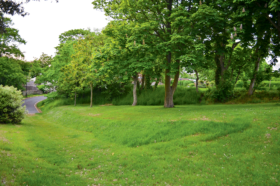
Early Bird Offer! Free tickets to meet independent experts at this summer's Build It Live
Save £24 - Book Now!
Early Bird Offer! Free tickets to meet independent experts at this summer's Build It Live
Save £24 - Book Now!Many buildings of particular architectural or historic interest are listed buildings; that is to say, they have been included on a list of protected buildings drawn up by English Heritage.
Special rules apply to building works that affect listed buildings, which can restrict potential for change and add cost to any project. So, if you’re contemplating a scheme that involves a listed building, ensure you understand what you’re taking on.
There are three grades of listing: Grade I, Grade II*, and Grade II. The vast majority of listed buildings fall within Grade II, with only a few exceptional buildings (think Buckingham Palace) in Grade I.
In Wales listing is administered by Cadw (part of the National Assembly of Wales). In Scotland the system goes from Grade A at the top end to C(S) for buildings of local importance, and is administered by Historic Scotland.
All listed buildings are subject to strict regulations aimed at preserving their historic structure and character both inside and out. Works to such a property require listed building consent. Unauthorised works are illegal and could result in you being fined.
You can find out whether a building is listed via Historic England or your local council’s planning department. Listing covers not only the building and its interior, but any outbuildings attached or adjoining.
Where listed building consent (LBC) is needed, it’s usually applied for in parallel with a planning application. Note that you’re likely to have to submit more detailed drawings for a listed building consent application than you would for a planning one – such as for joinery and window details.
The local authority will want to see that you have the interests of the property at heart. This will add to your application costs, although mercifully there’s no additional fee to pay the council.
After you’ve done careful research into the building and formed an outline of your plans, it’s advisable to consult with your conservation officer, if your local authority has one.
If not, other options include arranging a formal pre-application (sometimes for a considerable free), or investing in good, independent advice from a conservation and listed buildings expert instead.
The forms for a listed building consent application are available from your local authority’s planning office or can be completed online via the Planning Portal. They are relatively straightforward to fill out. Unlike with planning permission, there is no fee for listed building consent.
The process requires a lot of supporting documentation, so attention to detail is vital and you’ll probably want to get specialist input. Here’s what you’ll need to include:
The design & access statement gives you an opportunity to detail the design decisions you’ve taken and explain how they are intended to minimise impact on the listed building and protect its significance. It’s also the place to set out your choice of materials and finishes, as well as explain how they’re compatible with the structure both visually and in terms of their physical performance.
The most important element of an application, however, is often the heritage statement. This might be a document in its own right, or for small schemes you may decide to include this as a section within the design and access statement.
What to include in a heritage statementThe extent and amount of detail needed for a heritage statement will vary considerably depending on the importance of the building and the degree of intervention your proposing. The below identifies the main areas you need to cover in your statement:
|
From rural barns to urban industrial and warehouse buildings, numerous listed properties have been successfully converted to residential use. Very careful attention must be paid to preserving as much of the existing building and its character as possible, including internal features such as fireplaces, stairways and even decorative finishes and old plasterwork.
It’s vital to work with a building designer with experience of listed buildings and who, ideally, has a good rapport with the council’s conservation officer.
The approach of these officers varies – some keen to preserve the original building, others happy to see the building evolve over the years. However, the latter approach can result in you being obliged to keep some unhappy additions or features from the 1950s, 60s or 70s which you’d prefer to remove.
The same planning considerations apply to converting listed buildings as to non-listed buildings, although in some cases the fact the building is listed can help you to justify conversion to a dwelling as opposed to some other, probably commercial-type use.
This is because the cost of converting a listed building is generally higher than that of a comparable non-listed building.
It’s possible to extend listed buildings, and perhaps surprisingly there are permitted development rights to do so, but listed building consent is always required alongside standard approval, regardless of whether that’s a planning application or permitted development.
Particular care is needed to ensure the extension is sympathetic in design, scale, detailing and materials. ‘Sympathetic’ is open to wide interpretation, from ‘the same’ to ‘completely different’.
Some conservation officers prefer shamelessly modern extensions to historic buildings so there’s no confusion as to where the original ends and the new begins. Others like new additions to be quite bland and low-key, so the original character of the building still predominates.
Buildings with a significant facade facing a street might be suitable for extension to the rear, out of public view, whereas the public face of the building is likely to remain sacrosanct.
Internal alterations and refurbishment of listed buildings can be a bit of a minefield. The problem is that it’s not always clear what is simply maintenance or repair, which doesn’t need listed building consent, and what is an alteration, which does.
As a general rule, repairs and maintenance carried out using the original materials and techniques, which don’t compromise the integrity of the historic structure, don’t need listed building consent.
Areas where problems often arise are replacement windows, repointing of brickwork, replacement of internal finishes (such as old stairways and fireplaces) and integrating modern kitchen and bathroom fixtures into an old building.
Read more: How to create more light in a period property
In regards to outbuildings, listed building protection includes any object or structure fixed to the building or within its curtilage (in the latter case, this is provided it forms part of the land and has done so since before 1st July 1948).
Since undertaking works that need listed building consent without permission is a criminal offence, it’s vital to stay on the right side of the law. You should therefore always double check with your local authority’s conservation officer to ascertain what’s considered to be significant before works start.
Top image: Whilst the Edmonsons’ home wasn’t listed, the barn next door was – so when they set about creating a light-filled kitchen extension, they faced restrictions in terms of the overall ridge height and which bricks they could use, among other materials.


Comments are closed.